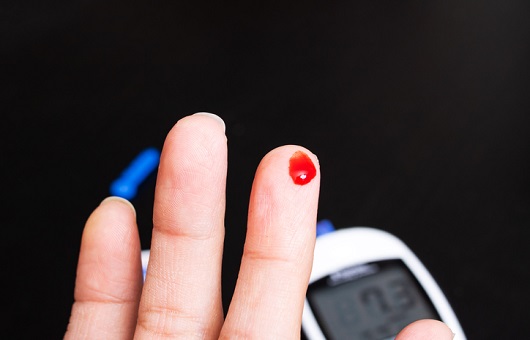Hidak and B&bit Gangnam Bright World, the story of the human eye that 4 ophthalmologists find out together. Every week we introduce diseases that damage your eyes and various ways to keep your eyes healthy.
Diabetic retinopathy is a disease that can damage the eyesight of diabetic patients. The number of patients with diabetic retinopathy is increasing every year. According to data from the Health Insurance Review and Assessment Service, the number of patients increased from 347,000 in 2015 to 389,000 in 2017 and 407,000 in 2019. Director Na Gun-hoo“Diabetic retinopathy is considered the number one cause of blindness in adults,” explained a variety of information from the cause of this disease to treatment methods.
Why Diabetes Damages Your Eyes
Diabetes adversely affects the eyes and vision. Diabetic retinopathy is a disease in which the capillaries of the retina are blocked due to diabetes, causing hypoxia, and causing swelling and bleeding around the blood vessels. Diabetic retinopathy is one of the leading causes of blindness worldwide. The longer you have diabetes, the more likely you are to develop diabetic retinopathy.
If you have diabetes and your blood sugar is not controlled consistently, the blood vessels in the retina burst and blood containing high sugar flows in. When diabetic retinopathy develops, blood vessels weaken and bleeding occurs, or fat components in the blood pass through the blood vessels and accumulate on the retina. This damages the blood vessels and tissues of the retina and leads to swelling of the cells around the blood vessels. In severe cases, the macula can be destroyed, leading to blindness. Even with thorough blood sugar control, most patients develop diabetic retinopathy 20 years after the onset of diabetes, which is sometimes called the ‘shadow of diabetes’.
Diabetic retinopathy is easy to neglect without obvious symptoms
In diabetic retinopathy, the blood vessels in the retina are damaged due to high blood sugar, and when the blood vessels do not function properly, circulation disorders in the retina occur. As mentioned earlier, it is a disease that causes vision loss and, in severe cases, even blindness. In the early stages, there are no symptoms and many people have normal vision, so most people may not know that they have diabetic retinopathy.
In diabetic retinopathy, symptoms are often not felt until the disease has progressed. Also, because the initial symptoms are like presbyopia, they miss the golden time of treatment and visit a hospital after the disease gets worse.
However, as time goes by, the vision gradually deteriorates. The symptoms are more dazzling, out of focus, or blurry vision than before. In addition, there are symptoms of nasopharyngeal flies flying, black dots appearing or moving. From this point onward, vision deteriorates further and can lead to blindness.

Early diagnosis of important diabetic retinopathy
In the early stages of diabetic retinopathy, it starts as ‘non-proliferative diabetic retinopathy’. Nonproliferative diabetic retinopathy, which accounts for the majority of diabetic retinopathy, does not cause blindness. However, if the disease is left unattended at this time, most will progress to ‘proliferative diabetic retinopathy’. In proliferative diabetic retinopathy, abnormal new blood vessels grow in the retina, causing intraretinal hemorrhage. In addition, it is necessary to be careful as it can lead to blindness with accompanying complications such as retinal detachment, which falls from the part where the retina should be. Therefore, for early diagnosis, it is important for diabetic patients to actively visit an ophthalmologist and receive regular examinations.
When and how to test for diabetic retinopathy
People with diabetes are about 25 times more likely to be blind than people without diabetes. In addition, after 20 years of onset of diabetes, 99% of patients with type 1 diabetes and about 70% of patients with type 2 diabetes will develop diabetic retinopathy.
For this reason, diabetic patients should be screened once a year, or at least every 6 months if they already have diabetic retinopathy. Once the retina is damaged, it is difficult to reverse it, so the earlier it is detected, the better the treatment effect.
In diabetic retinopathy, the visual acuity is measured first, and the pupil is enlarged to examine the retina using a slit or the like. If necessary, fluorescence fundus imaging (a test that obtains retinal pictures using a special camera, which helps to clearly see retinal blood vessels) and OCT imaging, which is optical coherence tomography, can be additionally performed to check the disease’s progress.
Fundus examination is essential for diabetic patients. Immediately after being diagnosed with diabetes, it is very important to check the condition of your eyes through regular fundus examination, even if there is no problem with your eyes.

Can diabetic retinopathy be cured? What is the treatment?
Unfortunately, when diabetic retinopathy begins to show vision deterioration, it is often out of control, and even good blood sugar control cannot completely stop the progression. It is still difficult to find a cure for retinal diseases including diabetic retinopathy. However, if diagnosed early and treated appropriately depending on the severity of the disease, complications of diabetic retinopathy can be prevented.
Treatment of diabetic retinopathy is carried out by selecting steroids, antibody injections, and laser surgery depending on the progress time and condition. Even if diabetic retinopathy has temporarily improved, treatment should be continued, and nonproliferative diabetic retinopathy should be treated with intensive blood sugar control and systemic disease treatment.
Treatment is divided into three main categories: antibody injection, panretinal photocoagulation, and vitrectomy. First, antibody injection therapy is a method to restore eyesight by directly injecting an antibody from an abnormal new blood vessel, which has a risk of bleeding in the eye, into the eye to prevent blood vessel bleeding and suppress the formation of angiogenesis itself. Panretinal photocoagulation is treated by making hundreds of clotting spots on the retina in 2 to 4 times. However, surgery is not possible if bleeding or retinal detachment has already progressed. Vitrectomy is an operation that removes the cloudy vitreous body and replaces it with a clear liquid while removing new blood vessels and the membranes surrounding the blood vessels in the retina.
To prevent diabetic retinopathy, you need to pay attention to your blood sugar.
There is no complete prevention of diabetic retinopathy, and diabetic retinopathy can develop in patients with all forms of diabetes. In addition to regular check-ups, diabetic retinopathy requires good blood sugar control. In general, controlling blood sugar can slow the onset and slow progression of diabetic retinopathy. If you check your blood sugar at least 3 times a day to completely control your blood sugar, you can prevent the progression of diabetic retinopathy by more than 76%.
Also, even if you do not have diabetes or diabetic retinopathy, if you are over 40, we recommend that you visit an ophthalmologist at least once every 6 months or a year for a detailed examination such as a fundus examination under the supervision of an ophthalmologist. We hope that you protect your eyes from various eye diseases such as diabetic retinopathy with regular eye exams.
Help = Dr. Geon-hoo Na, a consulting doctor at Hidak (B&bit Gangnam Bright World Ophthalmology Specialist)
–
![Diabetic patients are 25 times more likely to be blind than normal people… Why? [눈+사람] Diabetic patients are 25 times more likely to be blind than normal people… Why? [눈+사람]](https://src.hidoc.co.kr/image/lib/2022/8/11/1660194926892_0.jpg)

